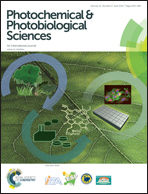Enhancing the output current of a CdTe solar cell via a CN-free hydrocarbon luminescent down-shifting fluorophore with intramolecular energy transfer and restricted internal rotation characteristics†
Abstract
A CN-free hydrocarbon fluorophore (Perylene-TPE) was synthesized as a new luminescent down-shifting (LDS) material. Its photophysical properties in both the solution state and the solid state were studied. The unity fluorescence quantum yield of Perylene-TPE observed in its solid state is considered to be from the characteristics of intramolecular energy transfer (IET) and restricted internal rotation (RIR). This is supported by the results from theoretical calculations and spectroscopic measurements. For the photovoltaic application of Perylene-TPE, a theoretical modeling study suggests that using the LDS film of Perylene-TPE may increase the output short circuit current density (Jsc) of a CdTe solar cell by 2.95%, enhance the spectral response of a CdTe solar cell at 400 nm by 41%, and shift the incident solar photon distribution from short-wavelength (<500 nm) to long-wavelength (>500 nm). Experimentally, placing a LDS film of Perylene-TPE on a CdTe solar cell can enhance its output Jsc by as high as 3.30 ± 0.31%, which is comparable to the current commercially available LDS material – Y083 (3.28% ± 0.37%).


 Please wait while we load your content...
Please wait while we load your content...